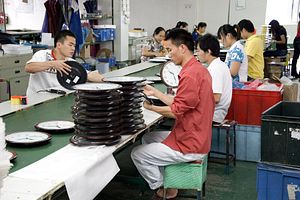China’s labor market is evolving from a mass of unskilled labor into one featuring an increasingly sophisticated labor force. While human rights abuses persist at some factories, labor conditions overall have changed, with increased union activity, better wages, and higher levels of education improving the plight of workers since 2008. Challenges in continuing to improve labor conditions are associated with China’s economic restructuring agenda, as labor demand and supply mismatches emerge in certain sectors.
First, we note that China is still struggling with poor labor conditions in some areas, and these have received increasing attention. Uniqlo was recently accused of violating labor rights in two Guangdong factories, and has since agreed to conduct air quality checks, curb excess overtime, and more. Apple has also faced ongoing accusations of labor abuses. Strikes against IBM, Pepsi, Walmart, and Nike suppliers in 2014 highlighted visible discontent among workers about subpar working conditions.
Workers appear to be more and more amenable to protesting poor conditions. Manfred Elfstrom and Sarosh Kuruvilla (2014) show that strikes have risen since 2008, and become increasingly offensive strikes in favor of better wages and working conditions, rather than defensive strikes against employer actions such as layoffs. This is in part a result of the Labor Contract Law of 2008, which extended protection of employees of at least ten years standing, prompting companies to improve capital-labor relations to some degree. Wages have risen since 2008, with wages highest in Beijing, Shanghai and Tianjun at around $2.60 per hour.
Labor supply and labor demand have also changed, altering the structure of the labor market. Intermittent labor shortages for labor-intensive jobs on the east coast have induced firms to move inland to access cheaper rural labor, and have tightened labor markets in labor-intensive manufacturing across the country. The working age population is also continuing to decline, which further reduces the low-skilled labor supply. At the same time, there is an oversupply of educated workers as increasing numbers of high school graduates go on to obtain university degrees, and shortages of vocationally skilled workers in middle-wage service sectors such as education. In response, the government is attempting to promote vocational schools, and has set a target of having 38.3 million students enrolled in vocational schools by 2020, an increase of about 9 million over the current enrollment levels. By contrast, the 2020 target for enrollment in higher education, such as four-year colleges, is 36 million.
University graduates, who often become white collar workers, have graduated to a new set of working conditions: underemployment, crowded living conditions, and low pay. The term “ant tribe” was coined several years ago to describe the many graduates who could not find suitable jobs and were forced to live with several roommates and work in subpar jobs at low wages. The types of jobs that are increasingly available are service sector jobs that cater to the domestic population. Many of these jobs are low-level positions that do not pay well.
More investment and regulatory changes will be needed to reform medium and high-skilled services sectors such as finance and communications to generate jobs. Serious service-sector growth hinges on the success of more sophisticated skill and technology-intensive service industries. Currently, competition for well-paying, higher-skilled jobs is high. Increasing investment and competition would initiate reform in these sectors similar to reform measures imposed on the manufacturing sector in the nineties. In this way, both four-year college graduates and vocational school graduates would be able to obtain better paying jobs. Once this is accomplished, the modern Chinese employee may truly have less to protest.

































